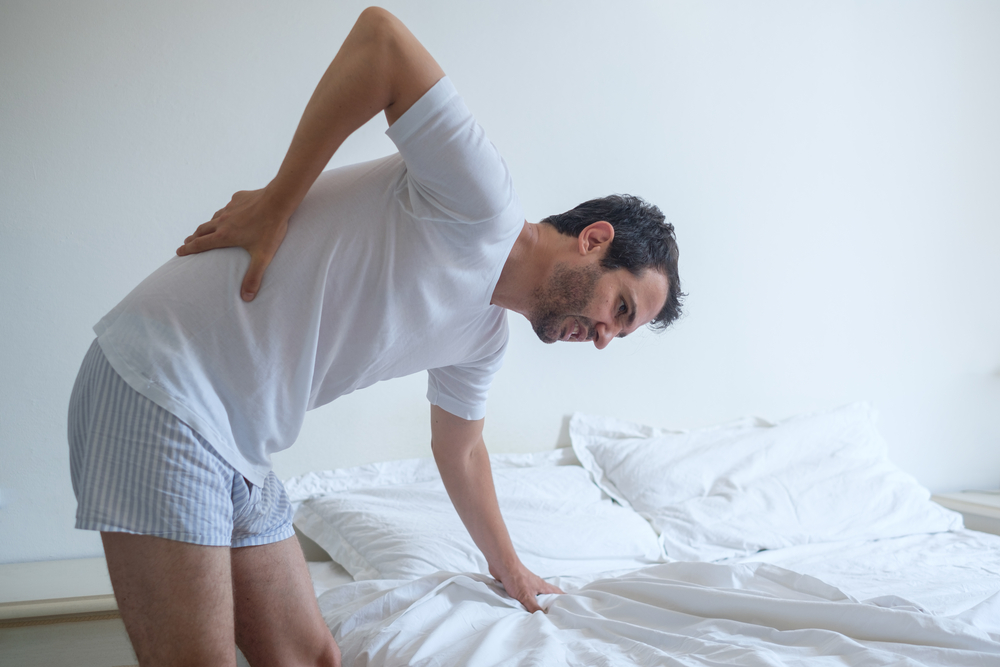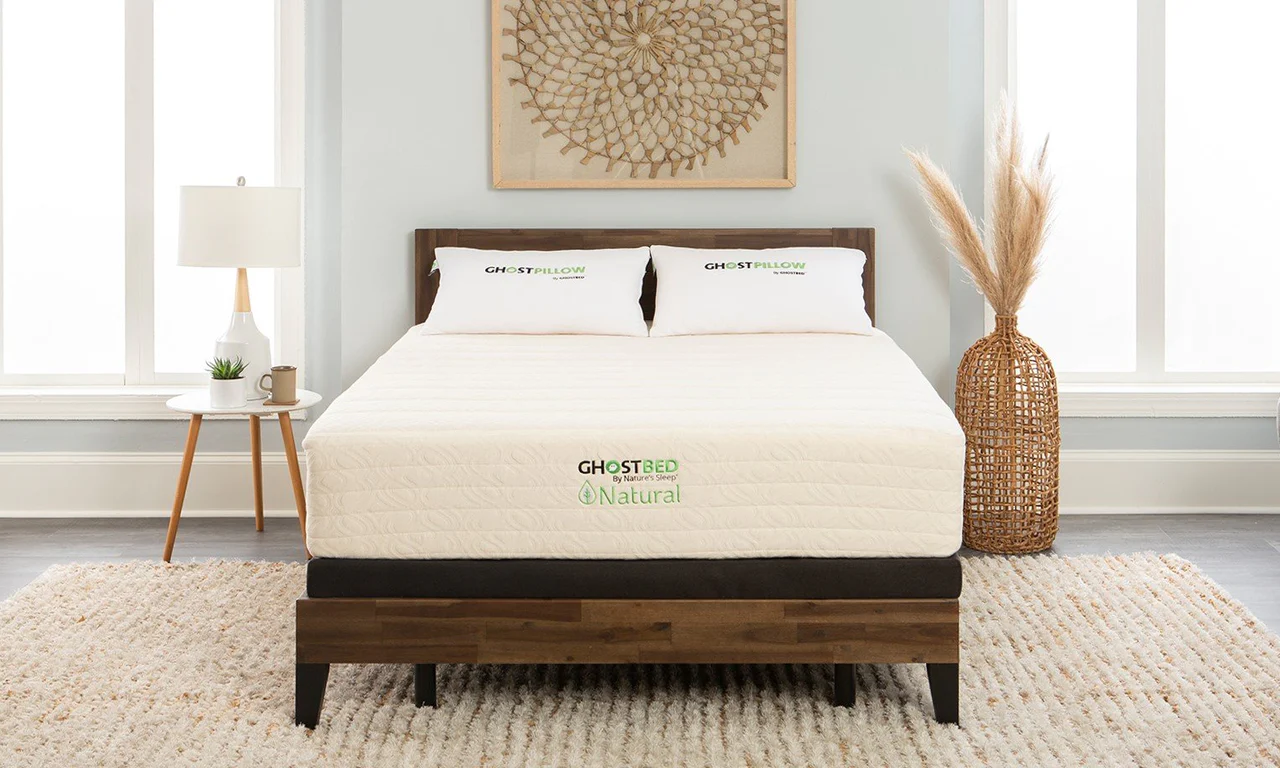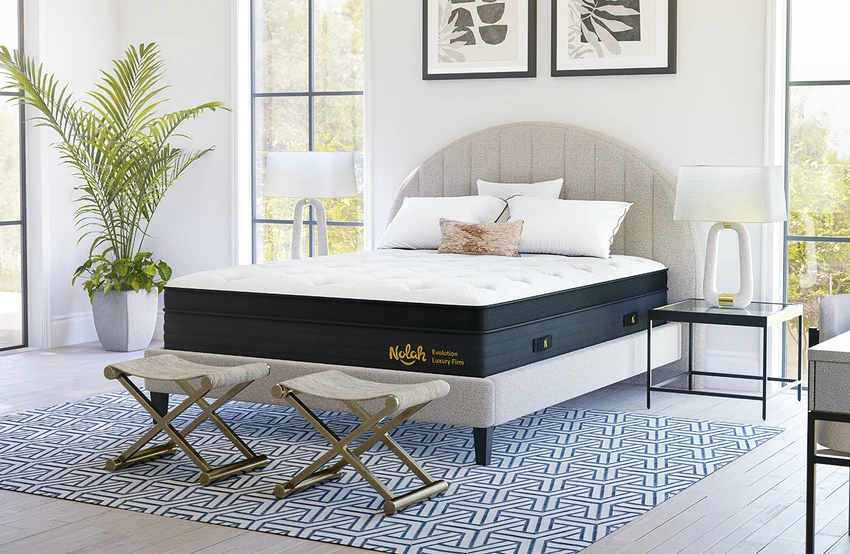Soft or Firm Mattress for Lower Back Pain
Last Updated: December, 2025
Please Note: This Post Contains Affiliate Links
Discomfort from lower back pain can be a barrier to sleep. Back pain makes it quite challenging to get comfortable and fall asleep, and can prevent you from staying asleep.
As you shop for the best mattress for your condition, be sure to keep in mind that your body weight plays a pivotal role when it comes to choosing between a soft and a firm mattress. A heavy sleeper may find a firm bed deceptively soft, while a light sleeper might not get enough give from a soft mattress.
The GhostBed Natural and the Nolah Evolution 15 are some of our top picks when it comes to choosing a mattress for lower back pain. They're specially designed to support your joints, back, and overall body. The Ghostbed Natural is best suited for those who need a soft mattress, the Nolah Evolution 15 suited for those who need a firm bed.
Keep reading to find out if a soft or firm mattress is better for your type of back pain, and what you can do to sleep better.
Types of Lower Back Pain
Lower back pain is the most common type of backache that affects the lumbar region (the lowest five vertebrae of the spine). Generally, there are two types of lower back pain.
Type 1 - Acute
Lower back pain is the most common type of backache that affects the lumbar region (the lowest five vertebrae of the spine). Generally, there are two types of lower back pain.
Type 2 - Chronic
Unlike acute lower back pain, chronic pain runs for up to three months or more and persists despite attempts to cure it. It can also involve sharp, intensive pain but may occur as a dull soreness or stiffness. While chronic back pain can sometimes be associated with a prior injury, it often has no immediate or clear cause.
Irrespective of whether lower back pain started suddenly or has become a long-term problem, individuals experiencing it should ensure they get checked out by a physician. Not only can a doctor help to relieve pain, but they can also conduct a complete diagnostic procedure to determine whether a severe underlying health issue is causing the pain.
Common Causes of Lower Back Pain
Sometimes, sleepers know precisely why their back is aching. Perhaps they lifted something awkwardly and immediately felt the pain. Or maybe their physician warned them for years that their bad posture would lead to back pain. However, other times, the source of the pain can feel like a mystery.
Whether you notice it or not, the lumbar spine works throughout the day. Amid all this motion, a strain can result from acute injuries like one experienced while lifting something too heavy or falling. A strain can also develop due to poor posture or repetitive movements.
Your physician can help you determine the right course of action that can help heal your condition. If your condition persists despite treatment, it might be time to look into other causes of chronic lower back pain.
Sleeping on an Uncomfortable Mattress
Unlike other body parts, the lower back section has more curvature, making it more susceptible to injury associated with posture and movement, including positioning during sleep. If your mattress offers insufficient support, your lower back may bend or twist in an unnatural way.
For instance, we've found that if your mattress is worn out or too soft, the hip section, which carries more weight, may sink deep into the surface and out of alignment. If the joints and spine aren't well-cushioned and aligned during sleep, the body will be strained, sowing the seeds for back issues and exacerbating pre-existing ones. And when this misaligned position is held for a long time at night, it can be a key contributor to lower back pain.
One of the easiest ways to know whether your bed contributes to lower back pain is if the pains and aches usually occur in the morning when you get out of bed. If you experience sharp back pains when you wake up and the pain subsides during the day, your current mattress might be playing a part in your pains and aches.
Herniated Disc
A herniated lumbar disc can occur when the inner gel of any of the five disks in the lumbar spine slips beyond the outer rind. This allows the inner gel in the cushiony disk to press on surrounding nerves, causing lower back pain. This slippage can be caused by trauma or age-related wear and tear.
Facet Joint Damage
The joints connecting the faucet joints (five vertebrae that make up the lower back) experience stress and large loads of compressive force. Over time, whether due to repeated overuse or poor posture, the breakdown of the cartilage in the faucet joint can lead to inflammation, stiffness, and lower back pain.
Using a Soft Mattress for Lower Back Pain
A soft mattress is usually recommended for individuals experiencing lower back pain on a standard bed or sleepers with pre-existing back issues. They're also a good pick for light sleepers as a harder surface can end up not compressing for these individuals.
When side sleeping, the shoulders, and hips bear the brunt of your body weight. Sleeping on a firmer bed can lead to pressure buildup around these sensitive areas. This tension might force you to toss and turn during the night to find comfort—resulting in poor sleep. We always recommend soft beds for lightweight side sleepers experiencing lower back pain, as they can keep the body supported and cradled to alleviate tension.
Since soft mattresses contour closely to your body, they can cause overheating. So, when shopping for a soft bed, ensure you go for one with cooling properties, like cooling gel, breathable, plant-based foam, or copper infusions.
What We Like
What We Don't Like
Overall Thoughts:
Unlike other GhostBed mattresses, the Natural model comes with Dunlop latex, a naturally breathable mattress material that feels both bouncy and responsive. If you prefer a responsive latex foam feel and you're experiencing lower back pains, this mattress might be all you need for a good night's sleep.
The GhostBed Natural Mattress features an organic cotton mattress cover. Aside from feeling soft and luxurious, this cover is free of hazardous chemicals and toxins. The comfort layers are made of natural wool, which helps disperse body heat and act as a natural fire barrier.
Underneath this sits a 2-inch Talalay latex foam layer that gently contours the body and offers excellent pressure relief. The GhostBed Natural Mattress boasts a high-density support layer made of individually-wrapped coils. Standing at 8 inches thick, these reinforced coils give sleepers a weightless feeling. And thanks to GhostBed's Dunlop latex base layer, lightweight lower back pain sufferers will receive sufficient support, so they can rest assured of having a pain-free sleep experience.
GhostBed offers a 25-year warranty on their Natural Mattress models. Each order also comes 101-night sleep trial period. If you aren't satisfied with your purchase during this period, you can return your mattress for a full refund.
Using a Firm Mattress for Lower Back Pain
For sleepers not experiencing chronic lower back pain, a firm mattress will be more comfortable. When resting on a firmer sleep surface, your bones absorb most of the pressure. This means less stress will be on your muscles, arteries, and veins. And when the muscles are less strained, blood circulation is improved.
A firm sleep surface also prevents your lower back from collapsing, which allows for more oxygen intake as you sleep. Less sagging can mean your body weight is distributed evenly, so no one section will bear the brunt of the pressure.
Firm mattresses will only hurt your back if you're a combination sleeper weighing between 130 and 230 pounds. A firm mattress usually works well for heavy sleepers and individuals who prefer to sleep strictly on their stomachs and backs.
If you're a side sleeper, sleeping on a firm bed will strain your muscles, and you'll get up with joint pain and even develop lower back pain.
And for persons with specific back problems like scoliosis and arthritis, a firm mattress can actually exacerbate pain. That's why it's crucial to research mattresses before committing to buy a new bed.
Related Content:
What We Like
What We Don't Like
Overall Thoughts:
A sleep surface that promotes spinal alignment can benefit sleepers who wake up with lower back pains or sore spots in their hips and back. The Nolah Evolution 15 Mattress features four foam layers to help cushion and contour to your body to evenly distribute your weight, improving your alignment, while a zoned support system pushes back against the extra weight from your midsection, significantly reducing sinkage.
The Nolah Evolution 15 uses open-cell foam layers to promote breathability and maximum air circulation. As a result, there will be little to no heat buildup during the night. The zoned coils will also help your mattress to perform well when it comes to ease of movement and edge support.
Nolah offers free ground shipping to customers within the contiguous U.S. Each order includes a 120-night sleep trial and a lifetime warranty against structural defects. For additional coverage, you can buy an accident protection plan to cover stains and other physical damages not featured in the standard warranty.
Factors to Consider When Buying a Mattress for Lower Back Pain
When buying a mattress to help relieve lower back pain, some bed features are more crucial than others. With so many mattresses in the market, it can be pretty challenging to parse out what really matters.
You're highly likely to make the most out of your purchase by focusing on the following key considerations:
Mattress Type
The mattress materials and design will play a pivotal role in the performance of your mattress. The bounce, firmness, motion isolation, and contouring of your sleep surface will be different for different mattress types. Therefore, you need to think about your priorities and choose a bed with components that will best suit your needs.
Firmness Level
Firmness is an essential driver of mattress comfort and is mainly a matter of personal preference. The right firmness level can also play a vital part in whether your mattress will offer sufficient support, and this will depend largely on your body weight and sleeping position.
Zoned Support
Weight from the body isn't always distributed evenly. Instead, certain parts tend to need more cushioning. A zoned sleep surface takes this into account and provides reinforced support in these areas.
How to Sleep with Lower Back Pain
Aside from your mattress, other sleeping accessories can play a significant role in making your sleep surface conducive to quality, pain-free sleep. For instance, you can upgrade your bed base and pillows as a lower-cost way to improve your mattress, or you can buy these along with a new bed for a complete overhaul.
Try a Mattress Topper
Buying a mattress topper is one of the best ways of changing the feel of your old mattress without breaking the bank. Instead of replacing your entire mattress, toppers allow you to put a fresh layer on top of your existing bed.
A major benefit of mattress toppers is that sleepers can take advantage of a comfort system that fits their unique needs and preferences. This includes changing the contouring or firmness to cushion your pressure points. For sleepers with lower back pain, the difference can be a meaningful step toward improved sleep.
Note that mattress toppers can't make a deteriorating bed feel "like new." If your current mattress is already sagging, your topper will also end up sagging. That said, a mattress topper is the best bet if you need to adjust the support or feel of your mattress, not when your bed has started to give out. Here are a few topper options for back pain.
Try an Adjustable Bed Base
The base of the bed can significantly contribute to a supportive sleep surface for patients with lower back pain.
Some buyers opt for adjustable beds, which allow the lower and upper body to be raised at different angles. Many adjustable bed frames also include a massage or heat feature that can be a perfect add-on for lower back pain sufferers.
Note that the optimal position for any individual on an adjustable bed base will greatly depend on their sleep position and the type of lower back pain they're experiencing. For instance, back sleepers often find that elevating their torso and legs slightly helps take pressure off their lower back. Before you buy an adjustable bed and set it up, ensure it's compatible with your existing mattress or get a new mattress for it. Click here for a review on the best mattress for adjustable beds.
Even if you're not buying an adjustable bed, take your time choosing the platform, base, or foundation for your mattress. Many manufacturers list recommended specs for the base, including the distance between the slats of the bed frame.
These guidelines will help keep your mattress in good condition and prevent premature sagging. Using approved bases may also be necessary to maintain your mattress' warranty.
Use Pillows
Generally, pillows are crucial in preventing and minimizing lower back pain. Aside from supporting your head, you can use pillows to provide cushioning, comfort, and support to other body parts. There are different types of pillows you can go for; memory foam, down pillows and many more.
Several factors affect the perfect pillow to best help fight back pain. For starters, the amount of loft of the pillow should fit your body shape and personal preference. The right loft level also largely depends on your sleeping position and the firmness of your mattress.
Below, we'll talk about how different sleepers can use pillows to support and relieve pressure in other parts of the body.
Stomach sleepers may relieve lower back pain by placing a thin body pillow below the pelvis to protect the lumbar area from sinking deep into the surface. Here are some good pillows designed for stomach sleepers.
Side sleepers can benefit from a body pillow placed beneath the knees. If you're a side sleeper, consider drawing your legs up towards your chest when you use a pillow to minimize pressure around the hips and the lumbar area.
Pillows for back sleepers should have low-to-medium loft and be placed beneath your knees to help maintain a more natural bend around the lower back.
Ways to Relieve Lower Back Pain for Better Sleep
Getting quality sleep is a crucial part of recovering from pain. However, sleeping well may seem daunting, especially when your lower back hurts.
The following tips can help you get better sleep with lower back pain:
Try Changing Your Sleeping Position
Changing your sleep position is one of the effective ways of getting lower back pain relief.
If you're a stomach or back sleeper with a soft bed and don't want to buy a new mattress, you can switch to a side sleeping position to help you receive more support from your current mattress. Generally, it's wise for stomach sleepers to try to adjust to back or side sleeping as it's much easier to get appropriate support in these sleeping positions.
For people with acute back pain, temporary changes to your sleep position may help minimize stress on already achy or sore parts of your back.
While this tactic is worth a shot, it's not a long-term fix, as the change can be pretty challenging to stick with. Some individuals just can't sleep comfortably in a different position, or they may end up reverting to their old style at night. In such cases, other approaches are likely to be helpful over the medium- to long term.
Exercise
Getting regular physical activity is a perfect way of improving your sleep quality. Consider doing targeted exercises to strengthen the core (muscles in your lower back, hips, pelvis, and abdomen). This lowers your chances of putting excess pressure on your back and experiencing muscle spasms as you sleep.
Yoga
Finding techniques to wind down, such as yoga, can help put an individual in the right state of mind for falling asleep with less focus on the pain. Talk to your physician about which poses can make your lower back pain worse and which are safe for you to practice. You might also consider using yoga props, such as blocks and bolsters, for added support.
When to See a Doctor
If you're experiencing back pain that's not responding to self-care and rest, it's time to consider scheduling an appointment with a doctor. In rare cases, lower back pain can be a severe medical issue. Seek immediate medical attention for back pain that:
- Is accompanied by a fever
- Causes new bladder or bowel problems
- Follows a blow to the back, fall, or other injuries
Your doctor may perform a physical exam and imaging scans to know the root cause of your pain. Depending on your diagnosis, they will then design an effective treatment plan aimed at alleviating lower back pain and preventing it from disrupting your daily activities.
Closing Thoughts
Both soft and firm beds have their pros and cons. Restorative sleep entirely depends on your body type and personal sleep preference. A medium-firm feel is perfect for most sleep positions and body types. However, if you prefer sleeping on your stomach or back strictly, you'll need a firmer mattress that offers more support and spinal alignment.
On the other hand, a softer mattress is a perfect choice for side sleepers and individuals who need comfort and pressure relief. And for lower back pains, you can also consider adding a suitable supportive pillow and a mattress topper.
Gabe is the newest member of The Sleep Shop team. If you like the design of The Sleep Shop, give Gabe a thumbs up. He’s a digital marketing and design guru and the brains behind the design and SEO of The Sleep Shop. He also won’t say no to testing a ton of mattresses either, and helps on almost every mattress review.
Learn More About Gabe



